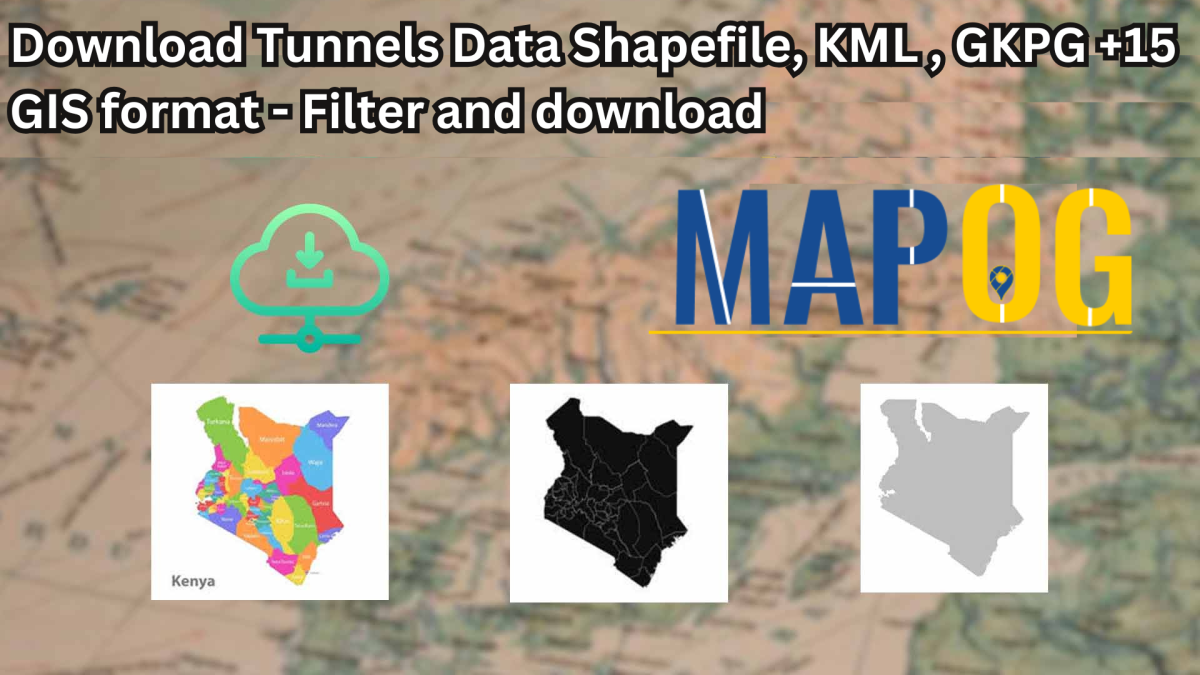Need accurate and structured tunnel location data? Download Tunnels Data with ease using GIS Data by MAPOG—a powerful and intuitive platform built to support GIS professionals, urban planners, engineers, and researchers. With support for 15+ popular formats including Shapefile, KML, MID, and GeoJSON, MAPOG makes tunnel data accessible, precise, and compatible with a wide range of GIS tools. Whether you’re analyzing underground infrastructure, transport networks, or safety zones, MAPOG offers reliable tunnel datasets that streamline your mapping and spatial analysis workflows.
How to Download Tunnels Data
GIS Data by MAPOG brings a guided, hassle-free experience to users aiming to Download Tunnels Data. The platform includes 900+ data layers and supports formats like SHP, KML, GeoJSON, MID, CSV, SQL, DXF, MIF, GPX, and TOPOJSON. Its interface is built for both beginners and experts looking for scalable data from global tunnel infrastructures.
Download Tunnels Data of any countries
Note:
- All data is provided in GCS datum EPSG:4326 WGS84 CRS (Coordinate Reference System).
- Users need to log in to access and download their preferred data formats.
Step-by-Step Guide to Download Tunnels Data
Step 1: Search for Tunnels Data
Start by entering “Tunnels” into the MAPOG search bar. You can navigate to the tunnel data layer and review its geometry type—whether it’s represented as lines or polygons. Attributes like tunnel type, length, usage, and status are also typically included.
Step 2: Use AI Search Tool
Harness the power of the “Try AI” tool for quicker searches. Just type in something like “Tunnels in industrial zones” and let the AI engine return curated datasets in seconds. It’s an efficient alternative to manual browsing, saving time and improving accuracy.
Step 3: Apply Data Filters
For more specific results, use the “Filter Data” option. Narrow your search by state or district to focus only on tunnel networks in your area of interest. This is especially useful when working with dense infrastructure datasets.
Step 4: Visualize with ‘Add on Map’
By selecting “Add on Map,” users can directly overlay the tunnel layer on the interactive map viewer. This lets you perform spatial analysis, observe network connectivity, assess proximity to key areas, and prepare detailed visual reports.
Step 5: Download Tunnels Data
Once your dataset is selected and reviewed, click on “Download Data.” Choose whether you want a sample or full dataset. Select from Shapefile, KML, MID, GeoJSON, or any of the other supported formats, accept the terms, and proceed to download.
Final Thoughts
With GIS Data by MAPOG, the ability to Download Tunnels Data becomes straightforward, flexible, and reliable. Whether you’re designing infrastructure projects or conducting academic research, this platform equips you with high-quality tunnel data in multiple GIS-ready formats. Explore, filter, visualize, and download—MAPOG simplifies every step of your data journey.
With MAPOG’s versatile toolkit, you can effortlessly upload vector and upload Excel or CSV data, incorporate existing layers, perform polyline splitting, use the converter for various formats, calculate isochrones, and utilize the Export Tool.
For any questions or further assistance, feel free to reach out to us at support@mapog.com. We’re here to help you make the most of your GIS data.
Download Shapefile for the following:
- World Countries Shapefile
- Australia
- Argentina
- Austria
- Belgium
- Brazil
- Canada
- Denmark
- Fiji
- Finland
- Germany
- Greece
- India
- Indonesia
- Ireland
- Italy
- Japan
- Kenya
- Lebanon
- Madagascar
- Malaysia
- Mexico
- Mongolia
- Netherlands
- New Zealand
- Nigeria
- Papua New Guinea
- Philippines
- Poland
- Russia
- Singapore
- South Africa
- South Korea
- Spain
- Switzerland
- Tunisia
- United Kingdom Shapefile
- United States of America
- Vietnam
- Croatia
- Chile
- Norway
- Maldives
- Bhutan
- Colombia
- Libya
- Comoros
- Hungary
- Laos
- Estonia
- Iraq
- Portugal
- Azerbaijan
- Macedonia
- Romania
- Peru
- Marshall Islands
- Slovenia
- Nauru
- Guatemala
- El Salvador
- Afghanistan
- Cyprus
- Syria
- Slovakia
- Luxembourg
- Jordan
- Armenia
- Haiti And Dominican Republic
- Malta
- Djibouti
- East Timor
- Micronesia
- Morocco
- Liberia
- Kosovo
- Isle Of Man
- Paraguay
- Tokelau
- Palau
- Ile De Clipperton
- Mauritius
- Equatorial Guinea
- Tonga
- Myanmar
- Thailand
- New Caledonia
- Niger
- Nicaragua
- Pakistan
- Nepal
- Seychelles
- Democratic Republic of the Congo
- China
- Kenya
- Kyrgyzstan
- Bosnia Herzegovina
- Burkina Faso
- Canary Island
- Togo
- Israel And Palestine
- Algeria
- Suriname
- Angola
- Cape Verde
- Liechtenstein
- Taiwan
- Turkmenistan
- Tuvalu
- Ivory Coast
- Moldova
- Somalia
- Belize
- Swaziland
- Solomon Islands
- North Korea
- Sao Tome And Principe
- Guyana
- Serbia
- Senegal And Gambia
- Faroe Islands
- Guernsey Jersey
- Monaco
- Tajikistan
- Pitcairn
Disclaimer : The GIS data provided for download in this article was initially sourced from OpenStreetMap (OSM) and further modified to enhance its usability. Please note that the original data is licensed under the Open Database License (ODbL) by the OpenStreetMap contributors. While modifications have been made to improve the data, any use, redistribution, or modification of this data must comply with the ODbL license terms. For more information on the ODbL, please visit OpenStreetMap’s License Page.
Here are some blogs you might be interested in:
- Download Airport data in Shapefile, KML , MIf +15 GIS format – Filter and download
- Download Bank Data in Shapefile, KML, GeoJSON, and More – Filter and Download
- Download Railway data in Shapefile, KML, GeojSON +15 GIS format
- Download Farmland Data in Shapefile, KML, GeoJSON, and More – Filter and Download
- Download Pharmacy Data in Shapefile, KML, GeoJSON, and More – Filter and Download
- Download ATM Data in Shapefile, KML, MID +15 GIS Formats Using GIS Data by MAPOG
- Download Road Data in Shapefile, KML, GeoJSON, and 15+ GIS Form
